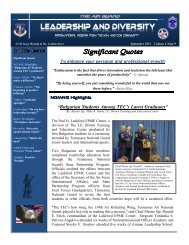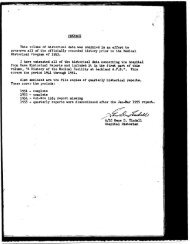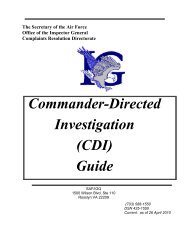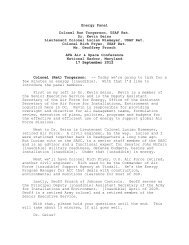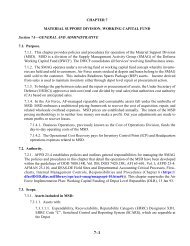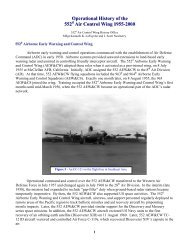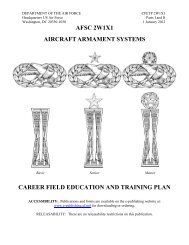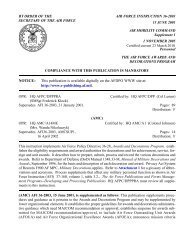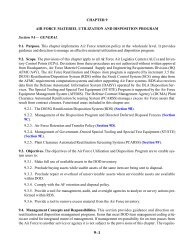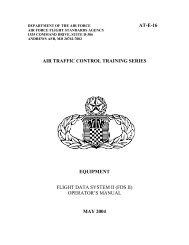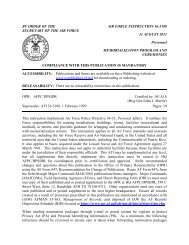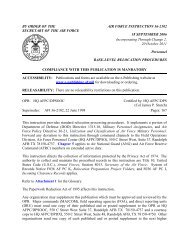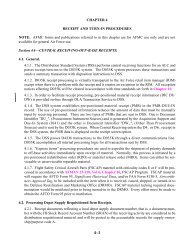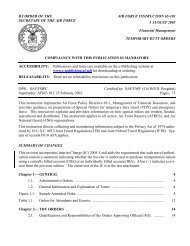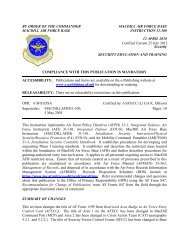CONTRAILS FACTS - Air Force Link
CONTRAILS FACTS - Air Force Link
CONTRAILS FACTS - Air Force Link
- TAGS
- contrails
- link
- www.af.mil
You also want an ePaper? Increase the reach of your titles
YUMPU automatically turns print PDFs into web optimized ePapers that Google loves.
The mission started back in World War II, when legions of American GIs fell victim to malaria<br />
and dengue fever, diseases spread by mosquitoes. The mission was taken over from the active<br />
force in 1973. Although most of the unit's missions are initiated by the Department of Defense,<br />
its services are also requested by local, state and other federal agencies and coordinated the<br />
Center for Disease Control. The most common missions flown are for mosquito, sand flea and<br />
weed control. Several states have also requested support to combat grasshoppers and locusts.<br />
Aerial spray missions have been flown in Puerto Rico, Panama, Guam and the Azores.<br />
The chemical compounds used for mosquito control are EPA controlled and the <strong>Air</strong> <strong>Force</strong> uses<br />
two primary brands; Dibrom and Anvil 10+10. Dibrom is manufactured by AMVAC Chemical<br />
Corporation and is classified as a Naled compound. Naled is an organophosphate insecticide<br />
that has been in use since 1959. It is used primarily for controlling adult mosquitoes but is also<br />
used on food and food crops, greenhouses and pet flea collars. Naled is applied using Ultra-<br />
Low Volume sprayers which dispense very fine aerosol droplets which kills the adult mosquito<br />
on contact. Naled is applies at a maximum aerial spray rate of 0.8 ounces of active ingredient<br />
per acre. Anvil 10+10 is manufactured by Clarke Mosquito Control Products, Inc and is a<br />
Sumithren, also known as a Synergized Synthetic Pyrethoid. Anvil 10+10 is applied using Ultra-<br />
Low Volume sprayers at a maximum aerial spray rate of 0.62 ounces of active ingredient per<br />
acre.<br />
The chemical compounds used for herbicide weed control are EPA controlled and the <strong>Air</strong> <strong>Force</strong><br />
uses Dupont Krovar I DF and Dow Agro Sciences Tordon K. Krovar I DF comes in granular<br />
form, is mixed with water and applied as an aerosol to control annual weeds at a rate of 4-6<br />
pounds mixed with 40-100 gallons of water per acre. Tordon K is used as a herbicide to control<br />
broadleaf weeds, woody plants, and vines on non-crop areas such as forest planting sites,<br />
industrial manufacturing sites, rights-of-way such as electrical power lines, communications<br />
lines, pipelines, roadsides, railroads, and wildlife openings. Tordon K is applied at a maximum of<br />
2 quarts per acre.<br />
The 910th <strong>Air</strong>lift Wing has formed an Oil Dispersant Working Group, and is working with<br />
industry and government agencies to test aerial spray methods of controlling major offshore oil<br />
spills in coastal waters of the United States. The unit has six Modular Aerial Spray Systems<br />
(MASS) and four aircraft modified to accept the MAAS. Each MASS has a 2,000 gallon capacity<br />
and flow rate are set at 232 gallons per minute. The aircraft flies at 200 Knots Ground Speed at<br />
about 100 feet which covers a swath width of 100 feet for an average application rate of flow<br />
rate of 5 gallons per acre (variable 3-15 gallons per acre). Total spray-on time for 2,000 gallons<br />
lasts about 8 minutes and 30 seconds.



